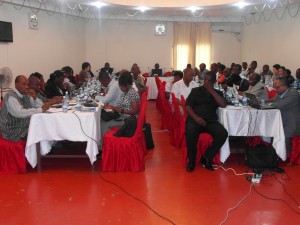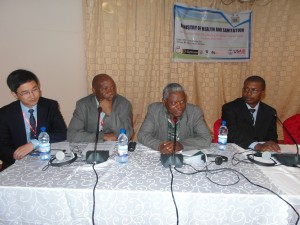Cross-Border Collaboration for NTD Control in Mano River Union Countries
February 25th, 2014
As national NTD program (NTDP) officials well know, communities in outlying areas such as border regions differ in many respects from those in other parts of the country. Their populations tend to be more transient and multi-cultural; they speak various languages and come from distinct ethnic groups.

Deputy Chief Medical Officer Dr. Sarian Kamara Opens 2013 MRU Meeting on NTD Control. Photo: J.Koroma/FHI360
Reaching each person with NTD drug treatments, as countries must do in order to break disease transmission, is extremely difficult in border regions for a variety of reasons. Countries on either side of the border may be in different phases of NTD control; they may not have fully scaled up mass drug administration (MDA) to 100% geographic coverage; and MDA activities may not be synchronized across countries, particularly if government support for the national NTD Program is lacking or if they depend on different NTD partners for funding and implementation support.
Mano River Union as an NTD Collaboration Vehicle
Recognizing that cross-border collaboration on NTD control would benefit everyone, the West African member states of the Mano River Union (MRU), originally created in 1973 by Sierra Leone and Liberia to collaborate on trade and economic issues, expanded that organization’s scope in 2006 to include discussions on cross-border onchocerciasis (river blindness) control, as well. Later on the members of the MRU, which now include Guinea and the Ivory Coast in addition to Sierra Leone and Liberia, further expanded that forum to collaborate on cross-border efforts to control five neglected tropical diseases (NTDs): lymphatic filariasis (LF or elephantiasis); schistosomiasis (SCH, bilharzia or snail fever); trachoma (blinding eye infection); onchocerciasis (Oncho or river blindness) and soil-transmitted helminthiasis (STH or intestinal worm infections).
At its most recent meeting, hosted by Sierra Leone’s NTDP in Freetown in October 2013, more than 6o representatives of the MRU Secretariat and NTD partners in the four countries,[1] as well as the officials from Sierra Leone’s Ministry of Health and Sanitation, the Freetown City Council and the 4th Estate in Sierra Leone, reviewed progress to date in NTD control and discussed program implementation challenges and potential solutions.
Current Status of NTDP Implementation in MRU Countries
While every country except the Ivory Coast has completed disease mapping, reaching 100% geographical coverage during MDAs remains challenging for most MRU countries. To date, Sierra Leone is the only country to have reached 100% geographical coverage for mass treatment of NTDs. In general, while the countries have made progress in expanding NTD treatment programs in recent years, mass drug treatment for SCH, LF, trachoma and STH is still not conducted in all endemic districts in every MRU country.
Steps toward Meeting the Cross-Border NTD Control Challenge
Increasing collaboration, communication and advocacy are at the core of the MRU meeting participants’ recommendations for improving cross-border NTD control. Among the specific recommendations are:
- Ensure that all MRU communications are bilingual (English and French), since many national NTD program representatives do not speak both languages.
- Use the MRU Secretariat for high-level advocacy with governments and the private sector on supporting cross-border control activities.
- Order additional NTD drugs for MDAs in MRU countries, since often more people are treated than planned, due to local residents’ constant movement among the countries.
- Include the MRU meeting in national NTDP budgets and annual work plans to ensure on-going NTD partner support for annual meetings.
- Synchronize MDA events among the MRU countries to the extent possible. All four countries should schedule mass drug treatments for Oncho and LF during September – December; and for SCH during June – July, prior to the end of the school year.
- Ensure that the MRU Secretariat is on the task force for organizing annual cross-border NTD meetings.
- Ask national NTDPs to advocate with their governments to partially fund annual NTD cross-border meetings and to share country work plans and semi-annual reports so that countries can learn from and support each other.
- Use the coordination committee for MRU meetings established in 2012 in the Ivory Coast to monitor implementation of these recommendations.
END in Africa Support for Cross-Border Coordination and Advocacy
National NTDPs within the MRU are still seeking a solution to one of their challenges: reducing their dependence on donor funding. The problem with depending on donors is that each has to follow the unique rules, regulations and timelines of its funding source, making it difficult for countries to synchronize the receipt of funds for NTD control and MDAs.
In addition to advocating with governments and the private sector to increase local support for NTD control, meeting participants would like to see NTD partners coordinate better among themselves as they collaborate on supporting national NTD programs. To this end, the END in Africa project plans to organize a one-time meeting (dates and location to be determined) of representatives from the MRU countries, other END in Africa-supported countries and their neighbors, and their NTD partners, to brainstorm on ways to improve partner coordination and collaboration to improve cross-border NTD control. Additional meetings with political leaders may follow to advocate for improving government contributions for NTD control.
Involving all the stakeholders in this conversation is key to increasing collaboration, coordination and advocacy on cross-border NTD control. When governments and partners commit to support each other and work together, we can tackle even the trickiest cross-border challenges and succeed in solving the sub-region’s NTD problem.
Stay tuned to the END in Africa website for more information on the upcoming meeting.
[1] Partners supporting NTDP implementation in the 4 countries include United States’ Agency for International Development (USAID), END in Africa (FHI360 and Helen Keller International, or HKI), the Centre for Neglected Tropical Diseases (CNTD) and Sightsavers in Sierra Leone; CNTD, Sightsavers and the the Organization for the Prevention of Blindness (OPC) in Liberia; HKI, CNTD, Sightsavers and OPC in Guinea; and HKI, CNTD and Sightsavers in the Ivory Coast. The African Programme for Onchocerciasis Control (APOC) is responsible for Oncho in all four countries, and will continue providing expanded support for both Oncho and LF under a new name after 2015.



